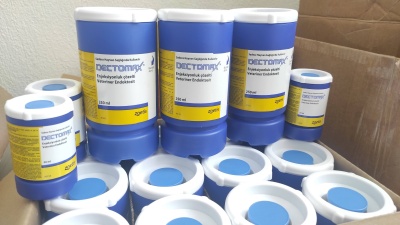Metacam 250 ml
metacam
Metacam 20mg/ml Solution for Injection Veterinary Non-Steroidal Anti-inflammatory Used in Animal Health Only
Composition: Metacam 20 mg/ml Solution for Injection; It is a sterile, yellow and clear solution for injection, containing 20 mg meloxicam in each ml and ethanol as a preservative.
Pharmacological Properties
Meloxicam is a non-steroidal anti-inflammatory drug (NSAID) belonging to the oxicam class, which inhibits prostaglandin synthesis and thus exhibits anti-inflammatory, antiexudative, analgesic and antipyretic effects. It shows anti-endotoxic properties by inhibiting thromboxane B2 synthesis created by E. coli toxin in cattle. It reduces leukocyte infiltration into inflamed tissue.
After a single dose of subcutaneous administration at a dose of 0.5 mg meloxicam/kg, the maximum plasma concentration (Cmax) in calves reaches 2.1 µg/ml after 7.7 hours, and in cows it reaches 2.7 µg/ml after 4 hours. It arrives after an hour.
More than 98% of meloxicam is bound to plasma proteins. It reaches its highest concentrations in the liver and kidney. Its concentration in skeletal muscle and adipose tissue is relatively lower. Meloxicam is found predominantly in plasma. In cattle, it is predominantly excreted with milk and bile, while only traces of the parent compound are found in the urine. Meloxicam is metabolized by oxidation in the liver, and the metabolites are pharmacologically inactive. The elimination half-life of meloxicam after subcutaneous injection is 26 hours in calves and 17.5 hours in cows.
The elimination half-life following intravenous injection in horses is 8.5 hours. Approximately 50% of the administered dose is excreted in urine and the remaining part is excreted in feces.
Target Species
For use in cattle and horses.
Metacam Indications
Metacam 20 mg/ml Solution for Injection is used in the following cases:
Cattle:
It is used to support antibiotic treatment in cases of acute mastitis, to reduce clinical symptoms by combining it with appropriate antibiotic treatment in acute respiratory infections, to reduce clinical symptoms in addition to oral fluid therapy in diarrhea seen in calves older than one week old and non-lactating calves, to relieve pain after dehorning.
Horses:
It is used to relieve inflammation and pain in acute and chronic musculoskeletal system disorders and to relieve pain in colic.
Usage and Dosage
Unless otherwise recommended by the veterinarian;
Cattle:
It is administered by subcutaneous (s.c.) or intravenous (i.v.) injection as a single dose of 0.5 mg meloxicam/kg body weight, combined with antibiotics in acute mastitis and acute respiratory infections, and with oral fluid therapy in diarrhea (Practical dose: Every 100 kg). 2.5 ml per body weight).
Horses:
In all indications, a single dose of 0.6 mg meloxicam/kg body weight is administered intravenously (i.v.) (Practical dose: 3.0 ml per 100 kg body weight).
In acute or chronic musculoskeletal disorders, treatment can be continued 24 hours after injection with Metacam 15 mg/ml oral suspension at a dose of 0.6 mg meloxicam/kg body weight. Contamination should be avoided during application.
Special Clinical Information and Special Warnings for Target Species
When applied to cattle before dehorning, it reduces post-operative pain. Its use alone is not sufficient to relieve pain during surgical intervention; it must be used together with a suitable anesthetic/sedative to relieve pain during surgical intervention. In order to best relieve possible pain after the operation, Metacam 20 mg/ml solution for injection should be applied 10 minutes before the surgical procedure.
Since it may increase the risk of toxicity to the kidneys, it should not be used in animals that are severely dehydrated, have decreased blood volume, or have low blood pressure, requiring parenteral fluid therapy.
NSAID use in animals with ulcerative gastrointestinal disorders (e.g. bleeding), liver, heart or kidney dysfunction causes an increased risk. If use is necessary in such patients, the animal should be carefully monitored.
When used in the indication of colic in horses, if it is not sufficient to relieve the pain, the diagnosis should be carefully reviewed again as surgical intervention may be required.
Use in Pregnancy and Lactation: It can be used in pregnant or lactating cows, but should not be used in pregnant or lactating horses.
https://docs.boehringer-ingelheim.com/MSDS/Metacam_Injectable_Dog_PI.pdf
Undesirable Effects
If an undesirable effect is observed, the application should be discontinued and a veterinarian should be consulted. Subcutaneous and intravenous administration is well tolerated in cattle. Mild temporary swelling was observed at the injection site after subcutaneous administration in 10% of the cattle. In horses, temporary swelling may occur at the injection site, which may be mild and heal on its own. Anaphylactic reaction, which can be severe (including fatal) in very rare cases








